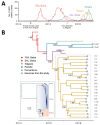Spread of Chikungunya Virus East/Central/South African Genotype in Northeast Brazil
- PMID: 28930031
- PMCID: PMC5621546
- DOI: 10.3201/eid2310.170307
Spread of Chikungunya Virus East/Central/South African Genotype in Northeast Brazil
Abstract
We investigated an outbreak of exanthematous illness in Maceió by using molecular surveillance; 76% of samples tested positive for chikungunya virus. Genetic analysis of 23 newly generated genomes identified the East/Central/South African genotype, suggesting that this lineage has persisted since mid-2014 in Brazil and may spread in the Americas and beyond.
Keywords: Brazil; ECSA genotype; East/Central/South African genotype; Maceió; Zika virus; chikungunya virus; dengue virus; genetic epidemiology; vector-borne infections; viruses.
Figures

References
-
- Ministério da Saúde. Boletins Epidemiológicos—Secretaria de Vigilância em Saúde. Situação epidemiológica / dados dengue. 2017;48:16 [cited 2017 Jul 13] http://portalsaude.saude.gov.br/index.php/situacao-epidemiologica-dados-...
MeSH terms
Substances
Grants and funding
LinkOut - more resources
Full Text Sources
Other Literature Sources
Medical

